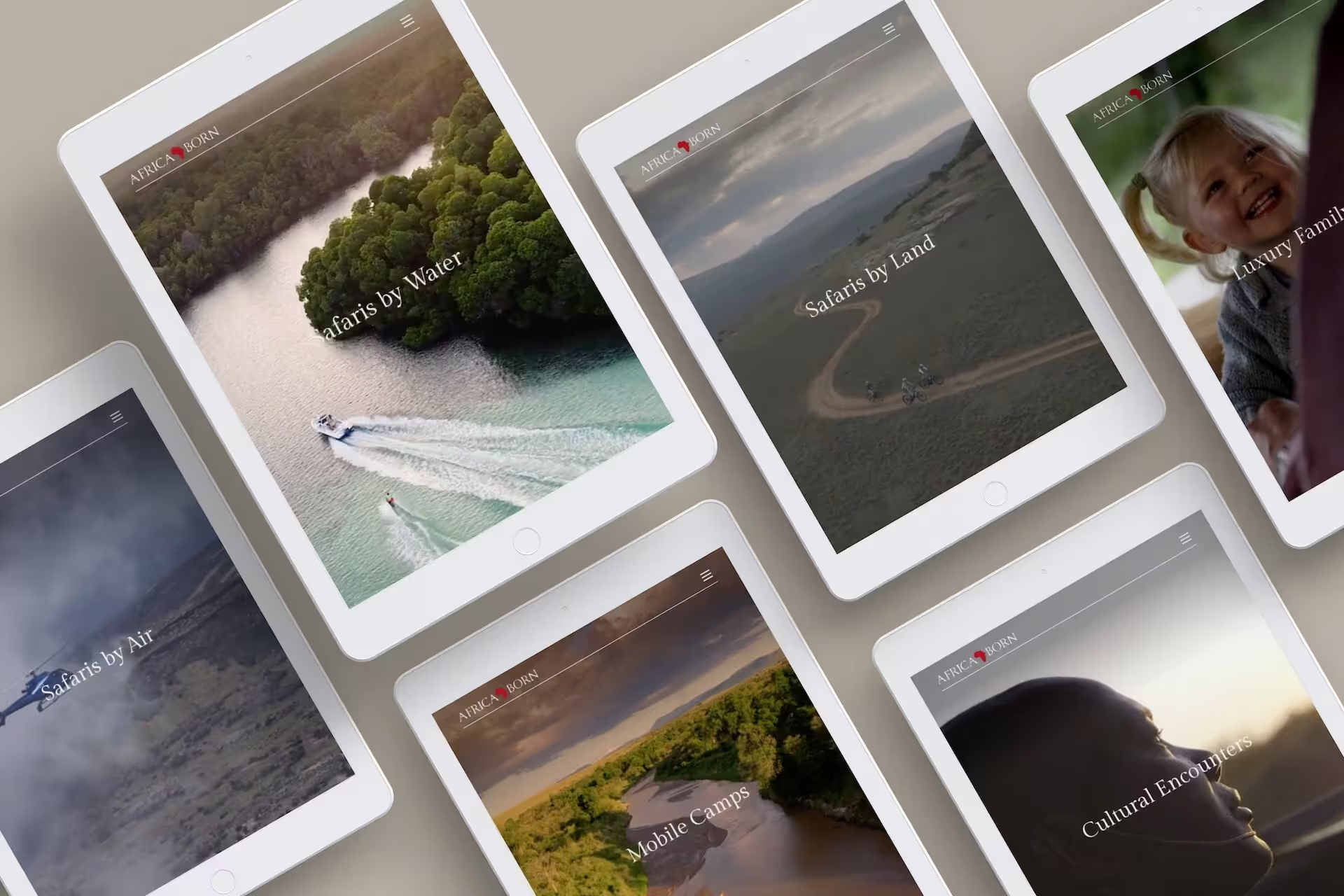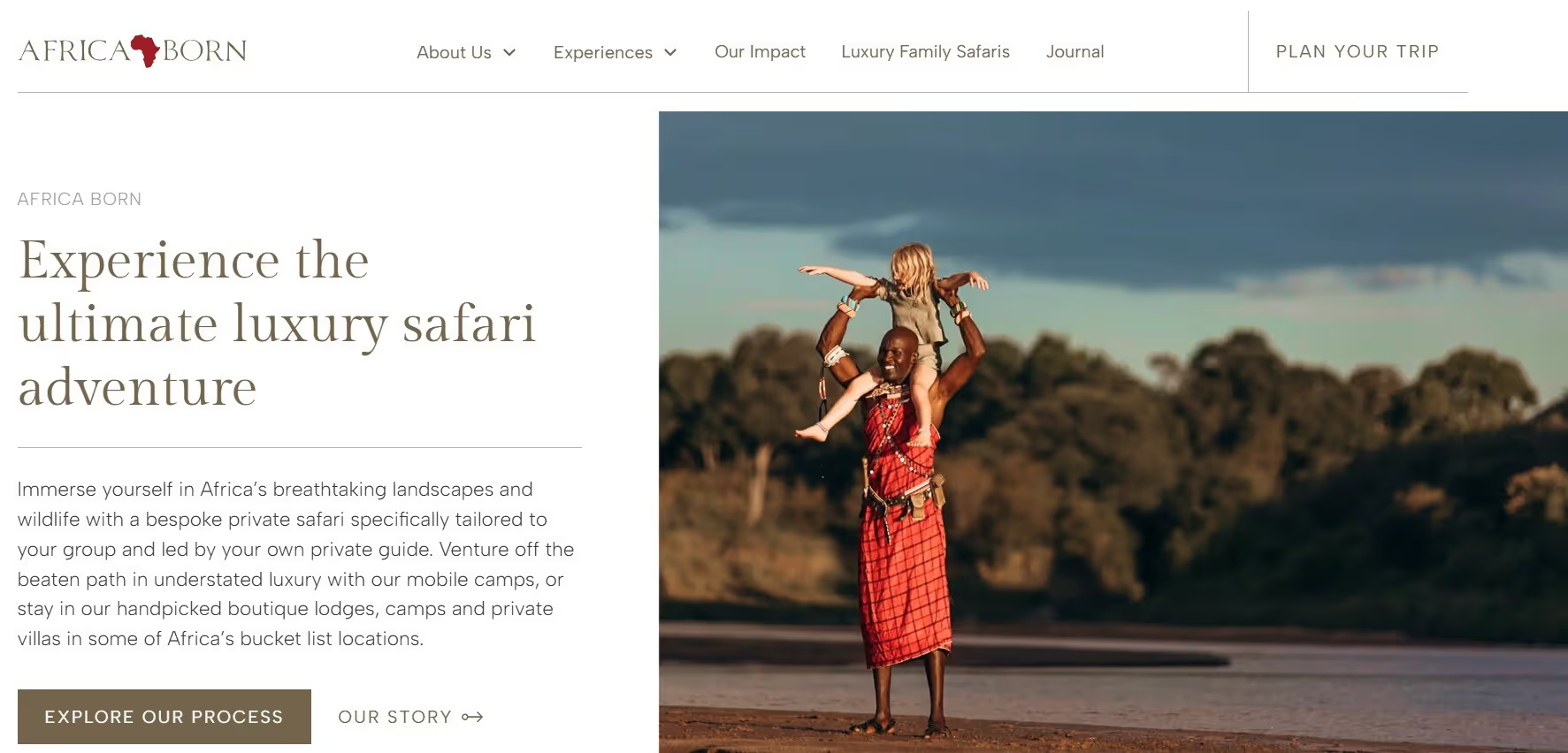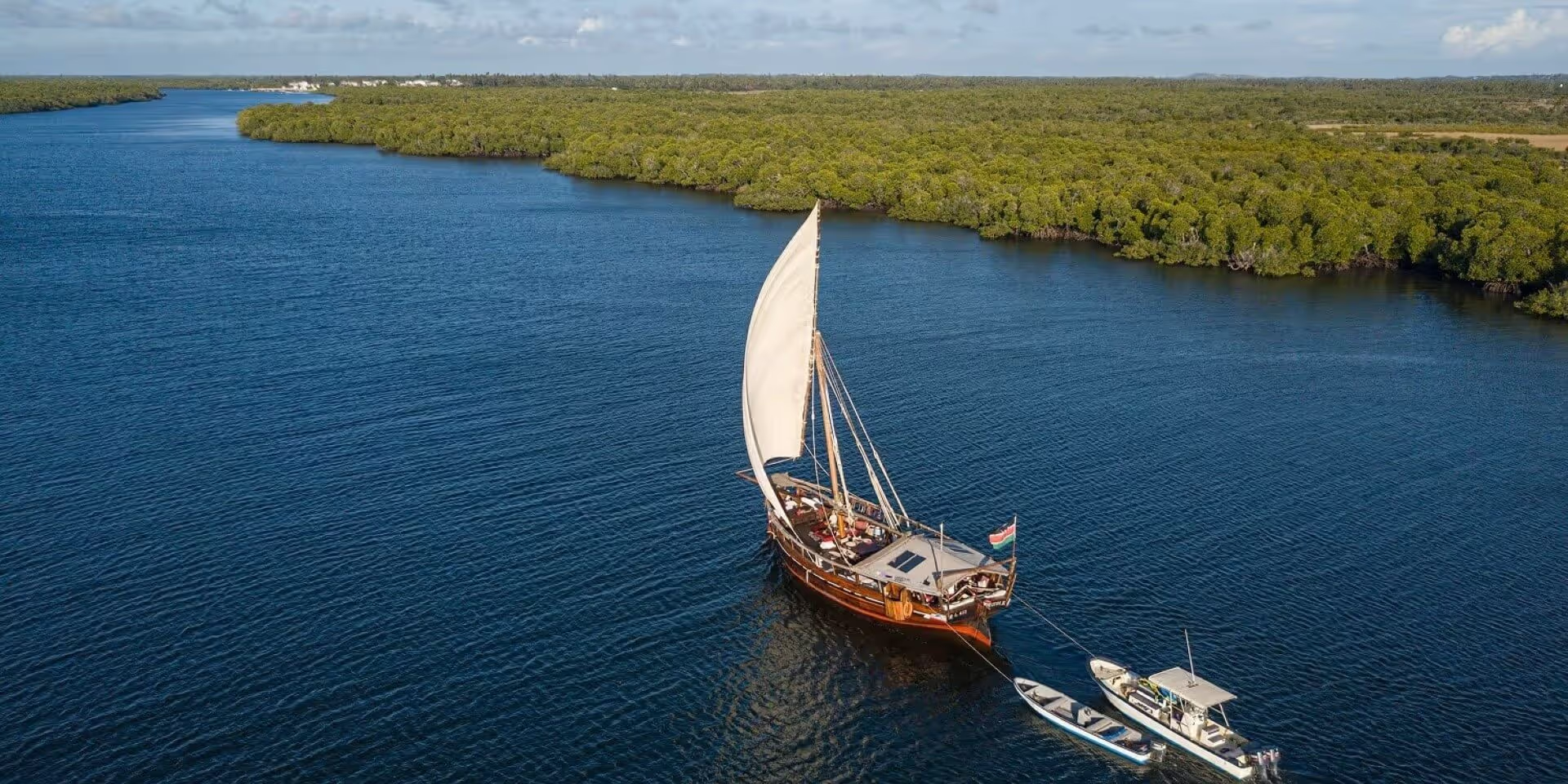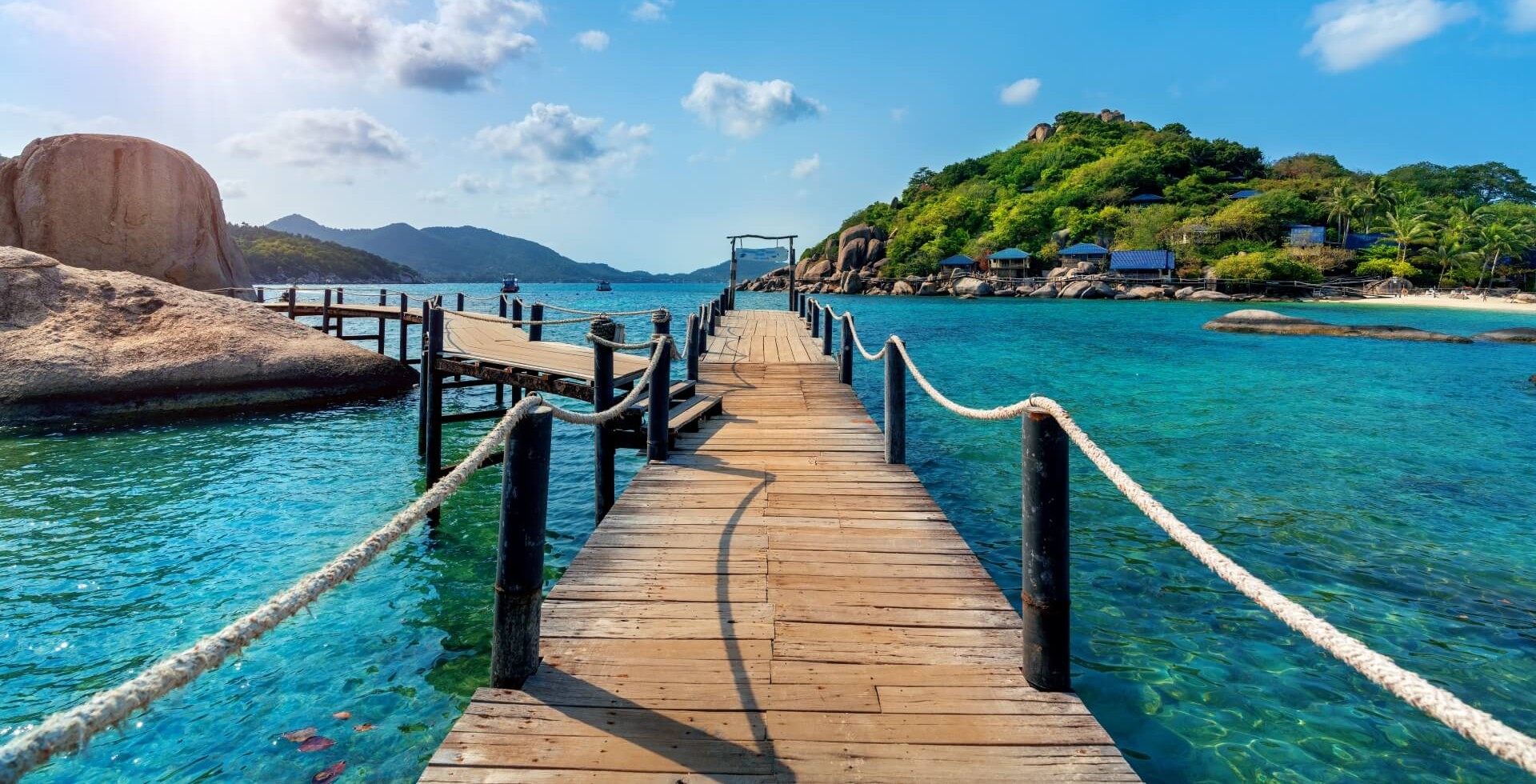We’ve seen it time and again: beautiful destinations undersold by bland digital experiences. You’re selling a feeling of freedom, exclusivity, transformation, or connection. Yet many luxury travel brands still default to marketing that’s structured around where the trip takes place, rather than how it makes the traveller feel.
That might work for mass-market travel. But high-end clients aren’t booking a holiday — they’re buying an experience that aligns with their lifestyle and aspirations. If your brand doesn’t reflect that, you risk being overlooked by the very audience you're trying to attract.
Let’s look at how luxury travel brands can shift their positioning to sell the experience, not just the destination, and how a recent website transformation for Africa Born, a bespoke safari operator, offers practical lessons in doing just that.
Why leading with location falls short in luxury
For many travel brands, it feels natural to organise and market trips by destination. “Kenya,” “Morocco,” “France”. These place names are instantly recognisable, will give you search volume, and offer travellers an existing idea of what’s on offer. But in the luxury space, relying on geography alone won’t set you apart.
Why? Because the destinations themselves are no longer the differentiator, but rather it’s about how your brand brings them to life.
Luxury travellers have access to almost every destination in the world. What they want is access to what others can’t see. Brands that lead with experience, instead of logistics, are far more likely to resonate with this audience.
Reframing how you present your offering
So what does that actually look like in practice? Here are five core areas luxury travel brands can use to shift focus from destination to experience:
1. User experience (UX): Design journeys, not directories
Your website and the journey users take should not resemble a catalogue of places. But rather, it should be a reflection of the kind of experience you promise your clients. Instead of listing destinations A to Z, curate journeys that align with the emotional value your brand delivers.
When we worked with Africa Born, we redesigned their website navigation to reflect how their safaris unfold (by land, air, or water) rather than by country. This restructured the customer journey to mirror how clients think about adventure, not geography. It also helped to subtly reinforce Africa Born’s ability to offer seamless, multimodal, fully tailored trips.

2. Visual storytelling: Make it immersive
Luxury travellers expect a strong visual impression from the start. That means fewer generic destination shots and more imagery that captures the texture of the experience: golden-hour lighting on a private deck, the quiet of a hot-air balloon at dawn, the welcome drink at a remote lodge.
Focus on details that show the level of service and exclusivity your brand offers. These kinds of visuals help potential clients imagine themselves on the trip and understand what makes your experience different.
This approach was central to our work with Africa Born, where we shifted the focus from places to the unique safari experiences they provide. We used their own photography and video assets to tell a story of immersion, not just information. This brings visitors as close as possible to the feeling of being on safari, from the comfort of their device.
Alongside photography, your overall visual identity, such as your colour palette, typography, and design style, should reflect the quality and personality of your brand. Consistency across all visuals builds trust and reinforces the feeling of luxury. This was a key part of our approach with Africa Born, where we refreshed their visual identity to match the exclusive, high-end experience they offer.
3. Copy and content: Sell the feeling
When you talk about your offering, are you listing what's included or what it feels like to be there? The most effective copy moves beyond logistics to emotion. But that doesn’t mean overly flowery language. Instead of writing something like, “Experience the ethereal majesty of the golden savannah bathed in the celestial glow of dawn’s first light as the majestic beasts roam freely beneath the sapphire sky,” focus on clear, vivid descriptions that help the reader imagine themselves there without making them reach for a dictionary.
Take Africa Born’s website before we worked on it: the content was dense and focused mostly on trip inclusions and destinations. We rewrote the copy to reflect a refined, experience-first voice that matched the high level of service they provide. Rather than just listing places, the copy now tells stories.
This kind of storytelling creates a connection with potential guests by helping them imagine the emotions and moments they will experience, without resorting to over-the-top language. It’s about making the luxury experience tangible and relatable, not just listing facts.

4. Brand voice: Align messaging
One common issue luxury travel brands face is a disconnect between sales and marketing teams. Marketing often focuses on the emotional experience, while sales talks features and logistics. This gap can confuse potential clients and weaken trust.
Aligning messaging across both teams ensures a consistent story at every touchpoint, from the first website visit to the final booking conversation. When your sales and marketing speak the same language, clients feel confident and understood, which makes it easier to convert inquiries into bookings.
5. SEO and data: Let strategy guide the story
Experience-led marketing may feel creative and emotional, but it needs a solid foundation in data and SEO to succeed. Understanding what luxury travellers search for helps you tailor your content to their interests and decision points, and to surface your brand where it matters most.
Africa Born’s increase in traffic to key experience pages after the relaunch shows how aligning SEO with storytelling works in practice. By researching relevant keywords, analysing user behaviour, and structuring content to meet search intent, you can craft pages that do two key things: first, get the search engines’ attention, but second, keep your target audience interested and engaged.
Plus, as AI plays a bigger role in search and content discovery, Google is doubling down on E-E-A-T, that’s experience, expertise, authoritativeness and trust. Experience-led brands already have an edge here. The key is making sure that edge is visible online, through credible, helpful and original content that reflects your authority and insight.
From repositioning to results
Repositioning your brand around experience is a strategic choice as much as a creative one.
Strategically, it means shifting how you define and communicate your unique value to better meet your target audience’s needs and expectations. This involves rethinking everything from website structure and content priorities to SEO focus and user journey, all to highlight what truly sets your brand apart.
Creatively, it requires crafting visuals, messaging, and design elements that embody the feeling and exclusivity of the experience you offer, rather than just the basic details or locations. The creative work supports and reinforces the strategic goal by making the new positioning clear, engaging, and authentic.
For Africa Born, this shift led to tangible results. Early SEO data shows an upward trend in traffic to key experience pages, and the new brand positioning has resonated strongly with their ideal audience. The design, copy and UX now match the exclusivity of their offering, helping them stand out in a crowded field and better convert high-intent enquiries.
By aligning the digital experience with the real-life experience they provide, Africa Born now presents themselves not just as a safari operator, but as a creator of once-in-a-lifetime journeys.
Final word: The right story sells
Experience-led travel is booming, but only if your marketing reflects what makes your experience unique. Africa Born’s transformation proves what’s possible when design, storytelling and brand positioning all pull in the same direction.
Luxury clients are making fast decisions based on long, emotionally-driven journeys. Make sure your digital presence reflects what your brand really delivers, not just where it goes.
Want your brand to feel as good as the journeys you offer? Let’s turn your digital presence into an experience worth remembering. Get in touch to start the conversation.




